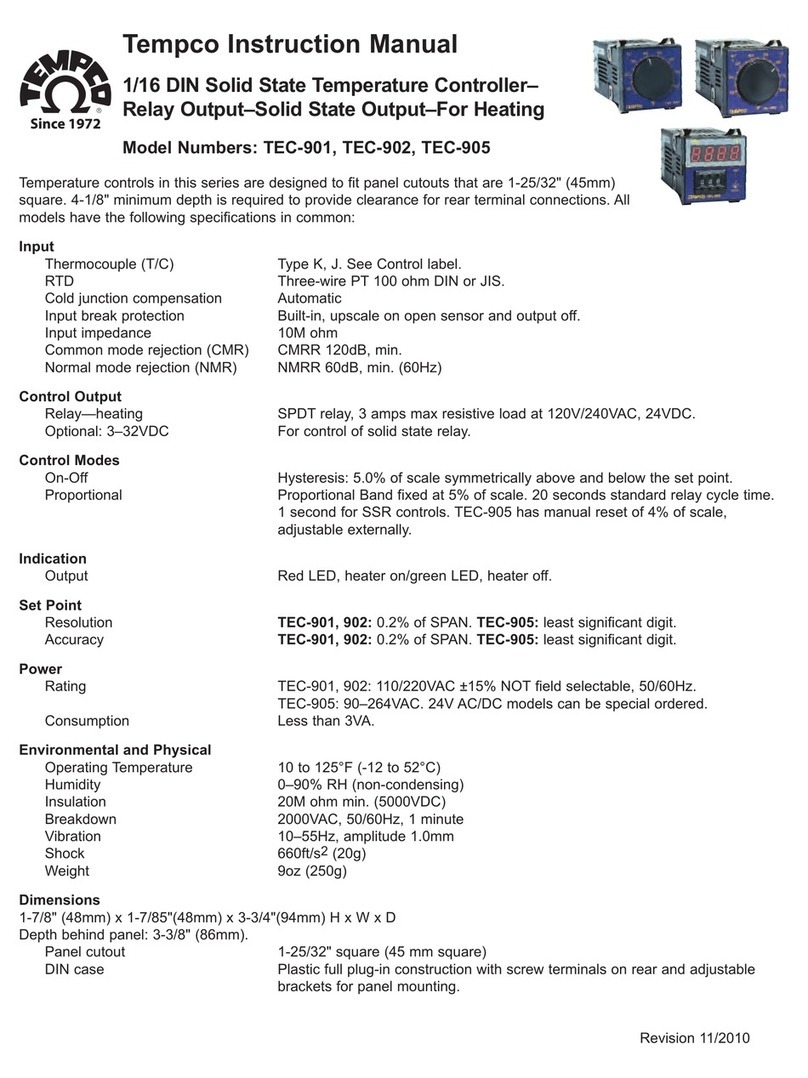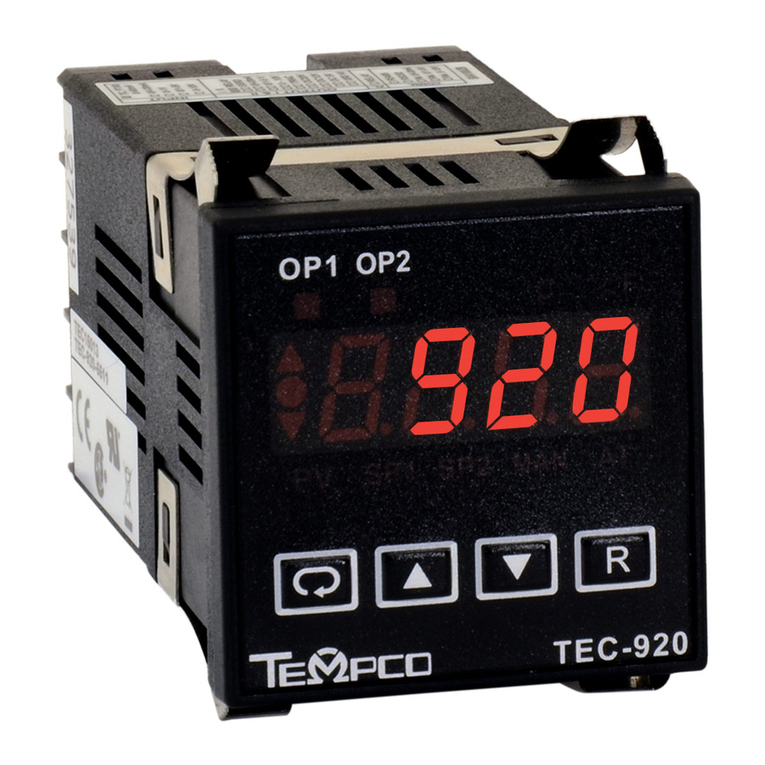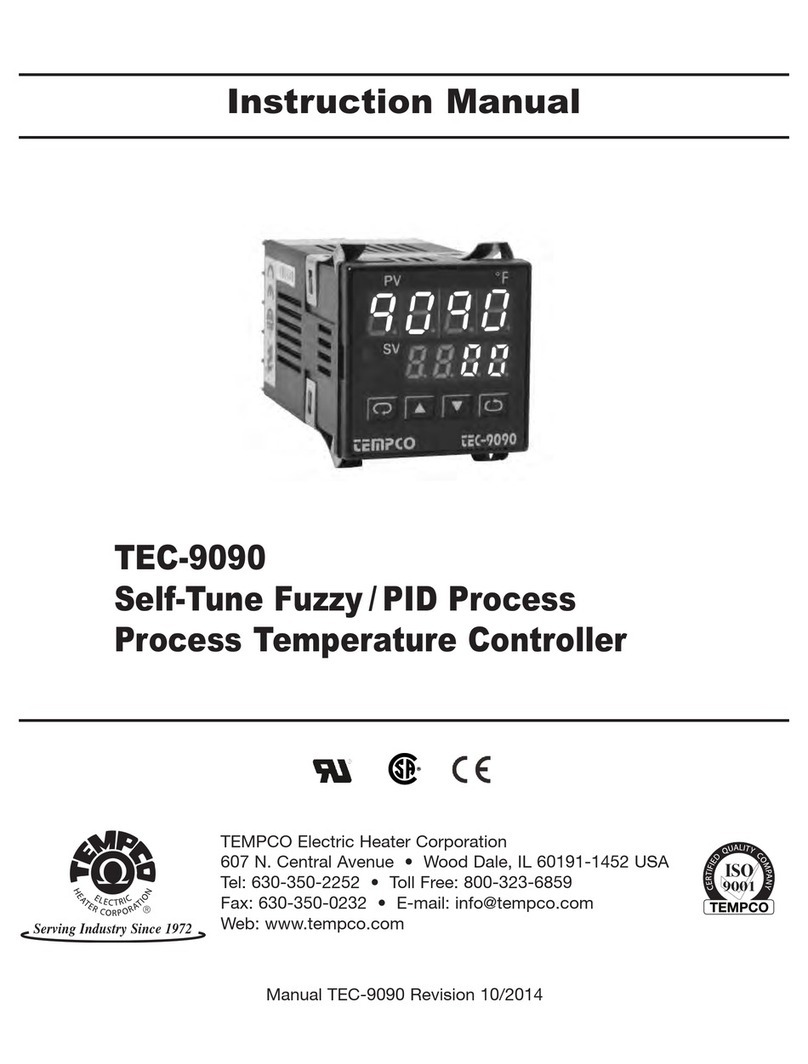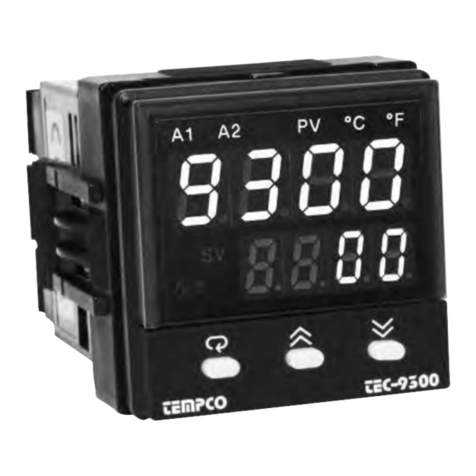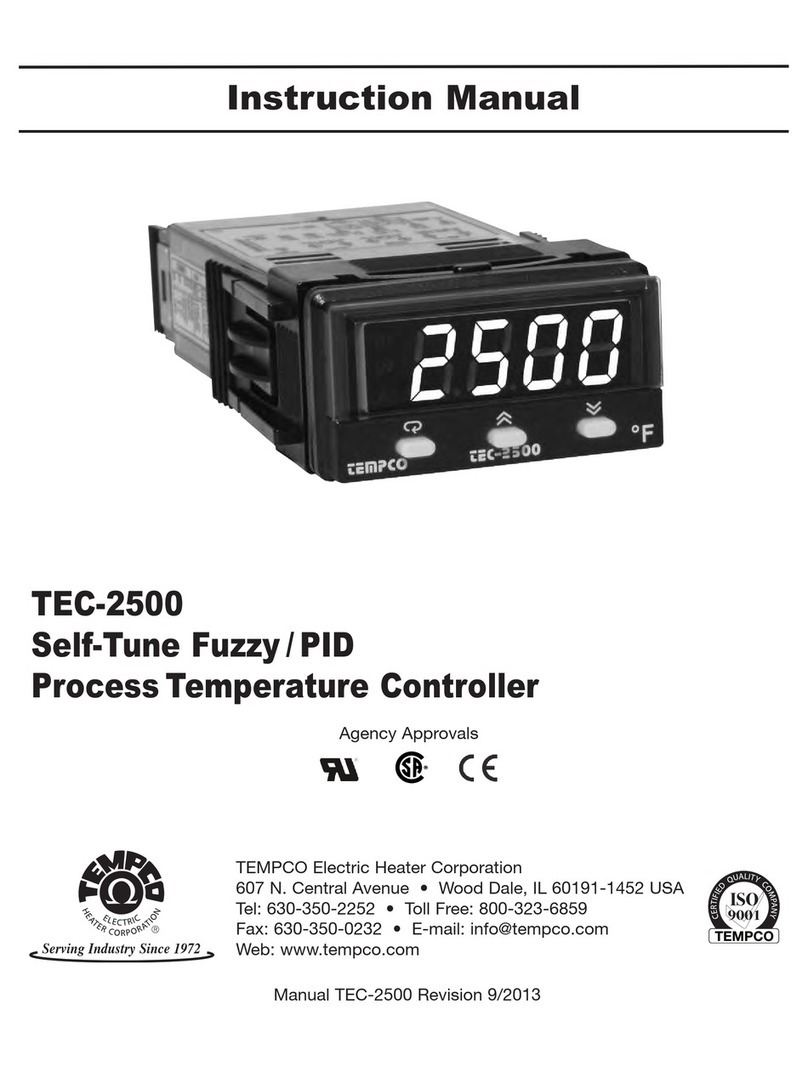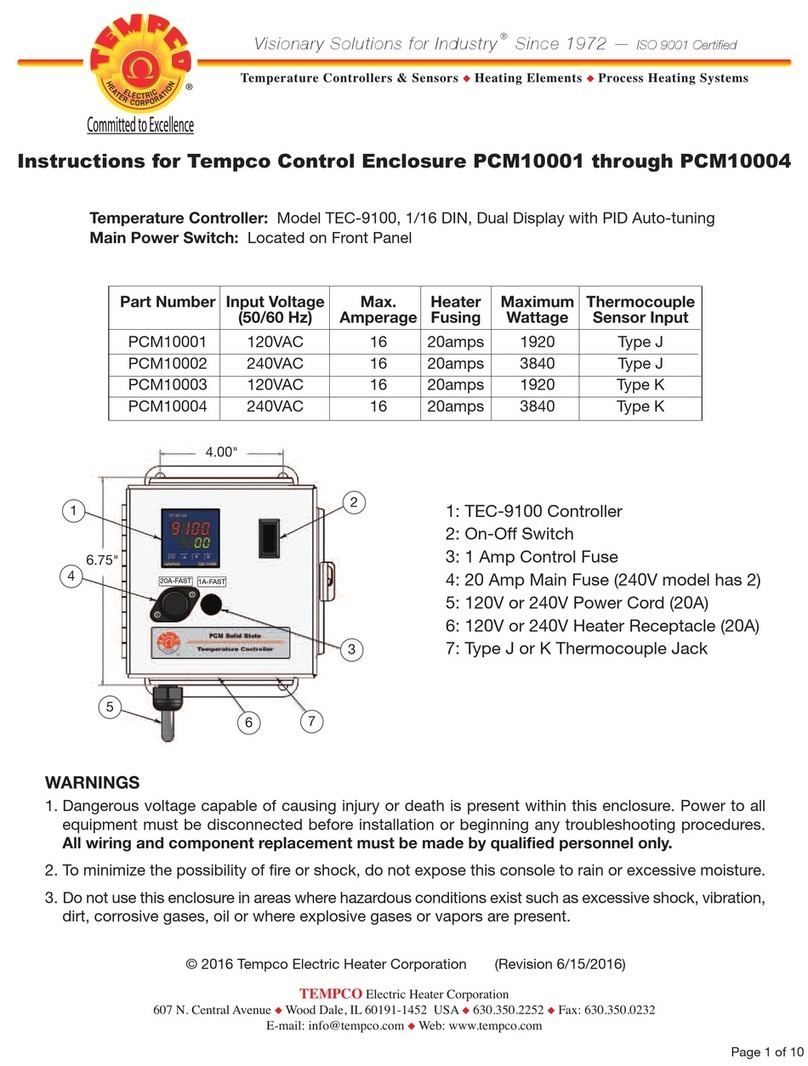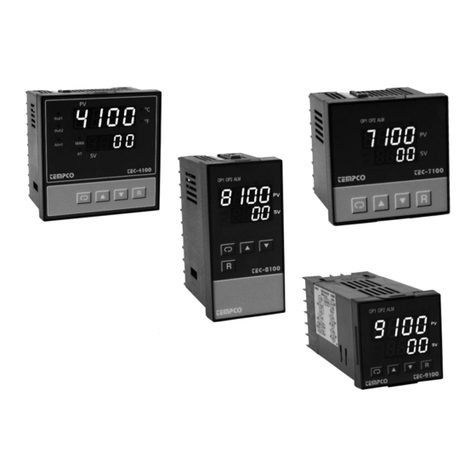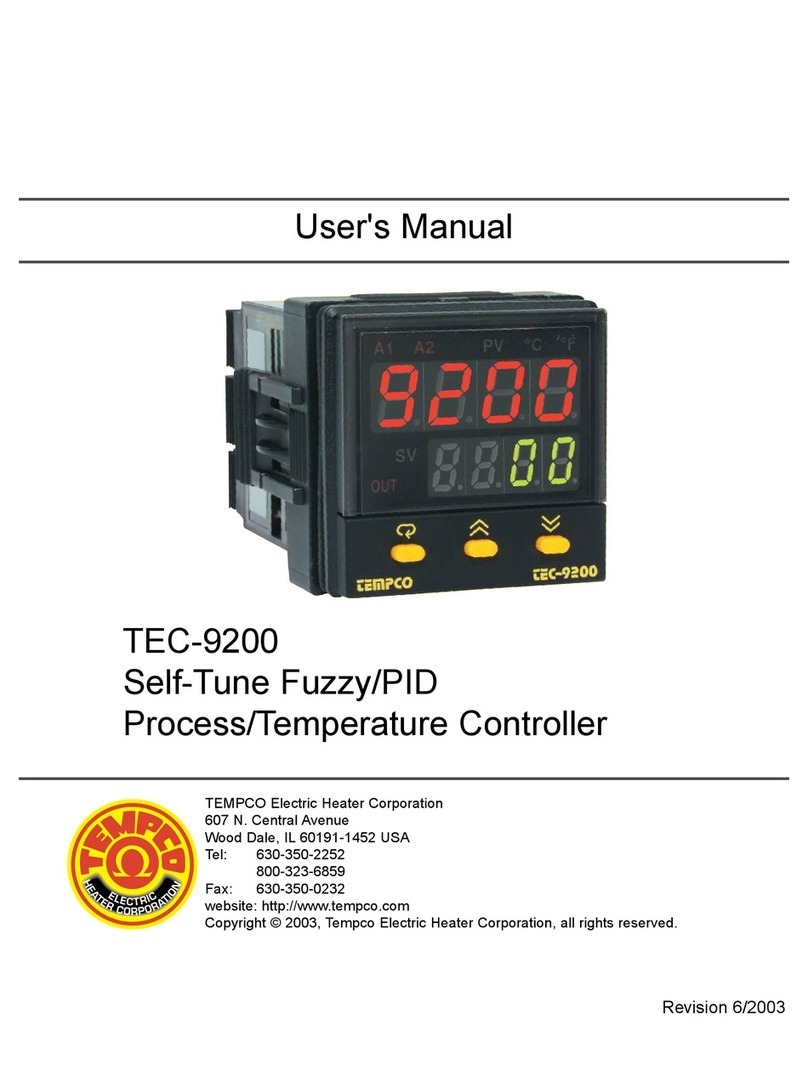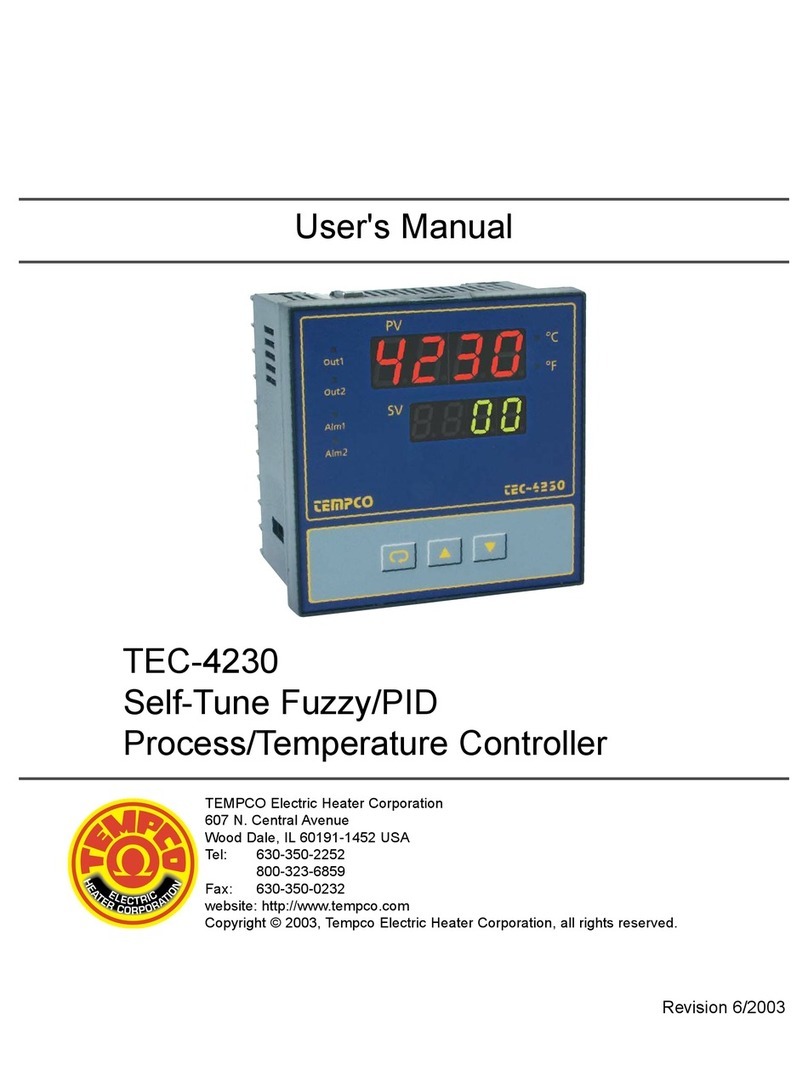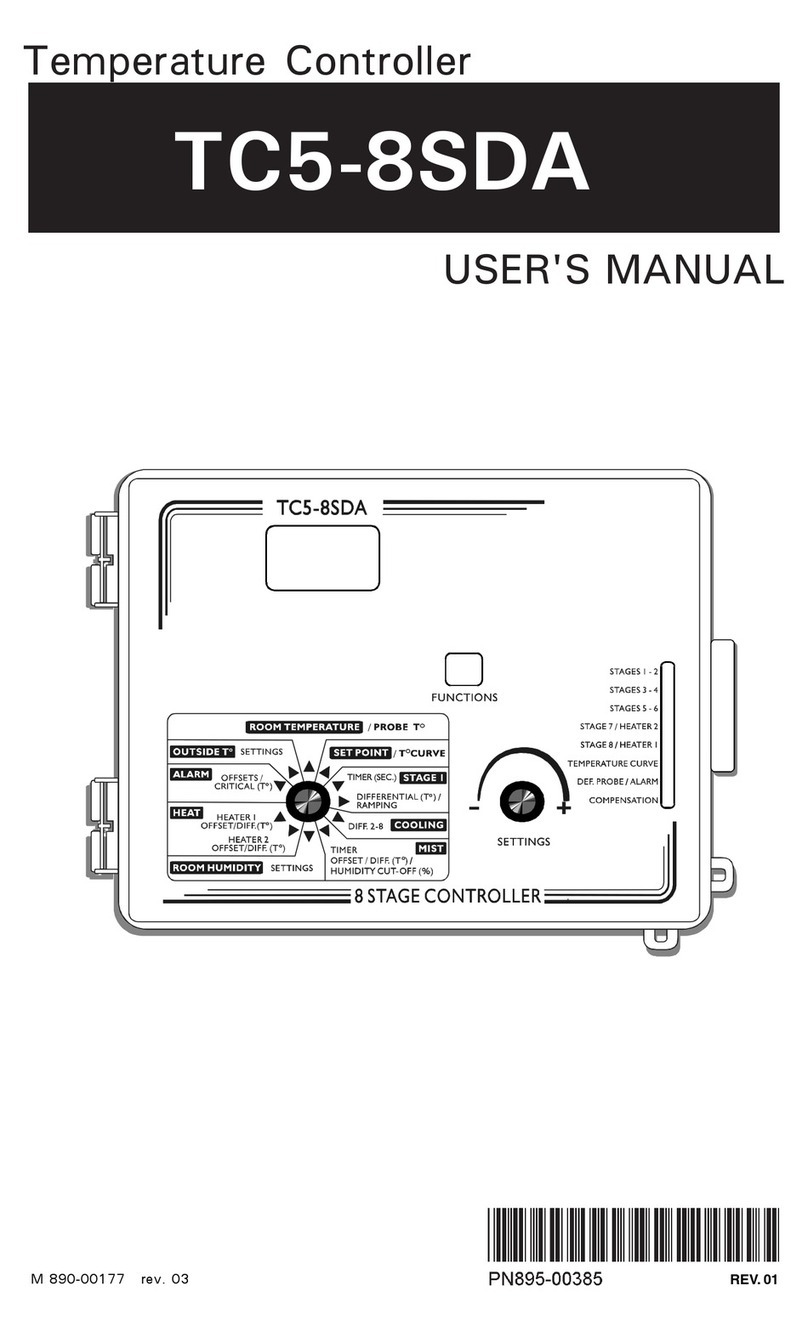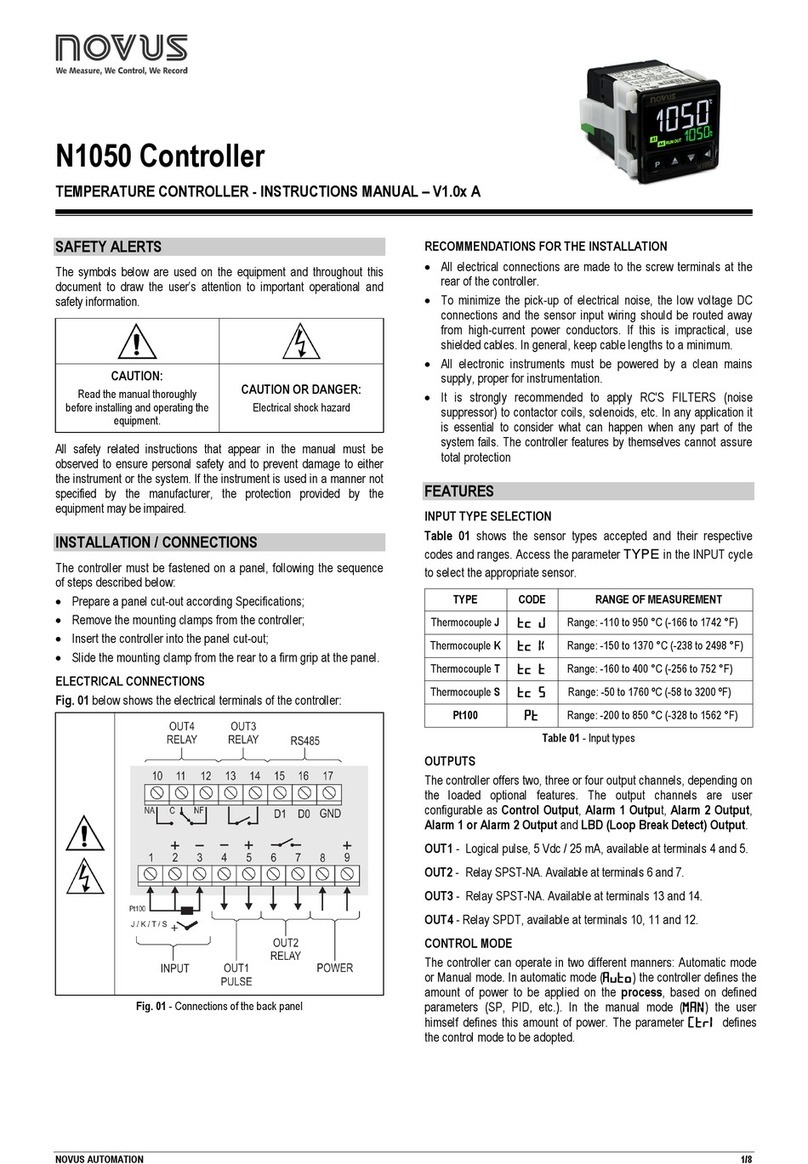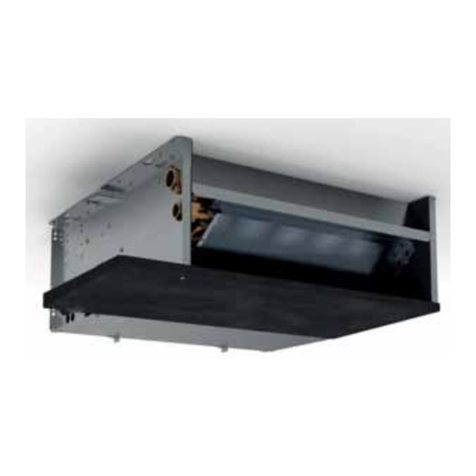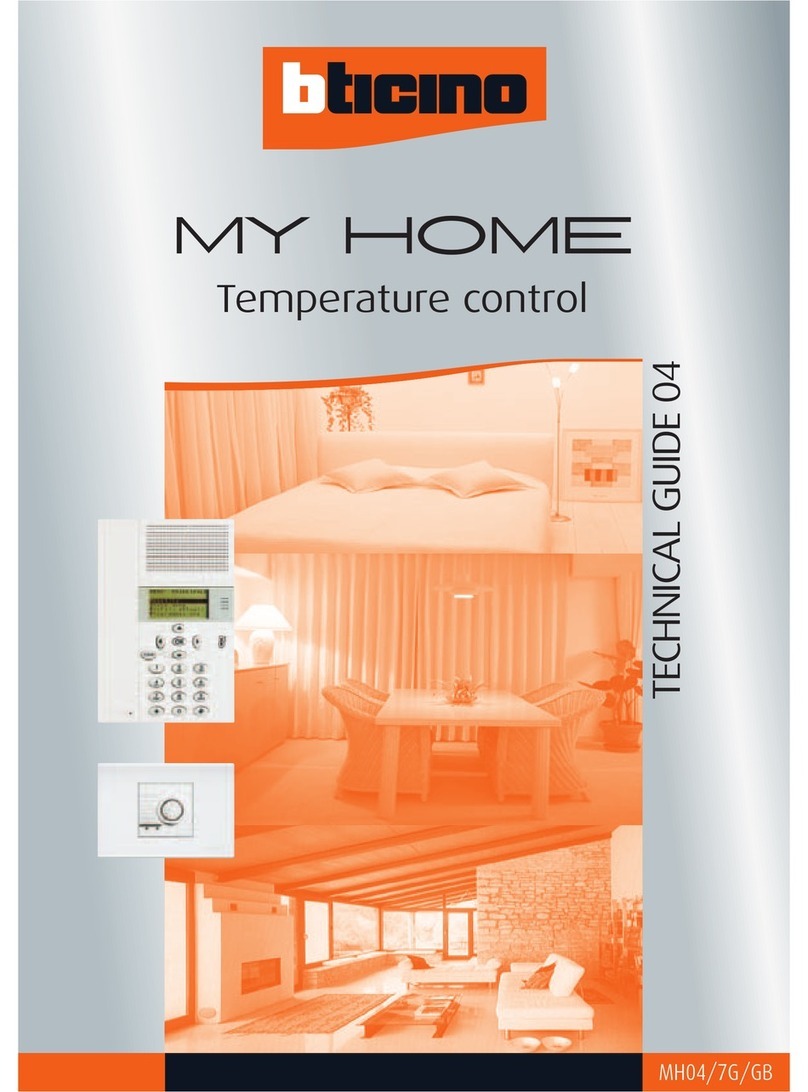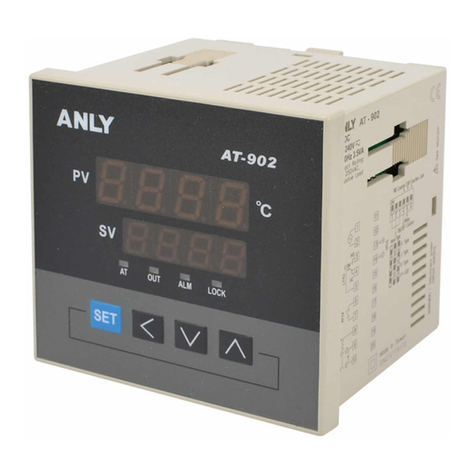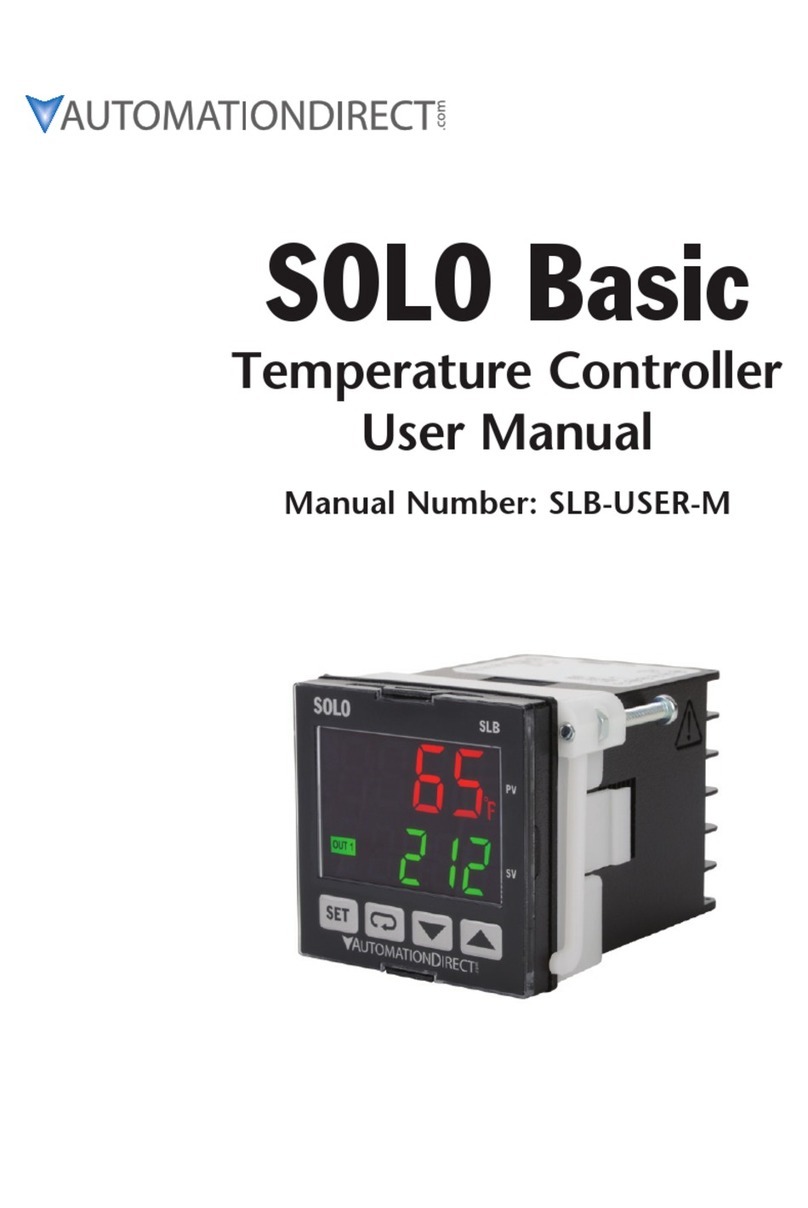Tempco TEC-9090 User manual

TEC-9090
Self-Tune Fuzzy Logic
PID Process Temperature Controller
D1306.TE-401-402-404-405 Revision 2/22/2019
USER MANUAL
Manual TEC-9090 • Revision 03/06/2019
D1306 • 4P200K17

NOTES

NOTE:
It is strongly recommended that a process should
incorporate a LIMIT CONTROL like TEC-910
which will shut down the equipment at a preset
process condition in order to preclude possible
damage to products or system.
Information in this user's manual is subject to change
without notice.
Copyright © 2019, Tempco Electric Heater
Corporation, all rights reserved. No part of this publi-
cation may be reproduced, transmitted, transcribed or
stored in a retrieval system, or translated into any lan-
guage in any form by any means without the written
permission of Tempco Electric Heater Corporation.
Contents
Page
Number
Chapter 1 Introduction 1
Chapter 2 Ordering Code 2
Chapter 3 Front Panel Description 3
Chapter 4 Input Range and
Accuracy 3
Chapter 5 Specifications 4
Chapter 6 Installation
6-1 Dimensions and Panel Cutout . . . . . . . . . . . 5
6-2 Wiring Diagram . . . . . . . . . . . . . . . . . . . . . . 5
Chapter 7 Wiring Precautions 6
Chapter 8 Operation
8-1 Keypad Operation . . . . . . . . . . . . . . . . . . . . 6
8-2 Flow Chart . . . . . . . . . . . . . . . . . . . . . . . . . . 7
8-3 Parameter Description . . . . . . . . . . . . . . . . . 7
8-4 Automatic Tuning . . . . . . . . . . . . . . . . . . . . . 8
8-5 Manual PID Adjustment . . . . . . . . . . . . . . . . 8
8-6 Manual Tuning Procedure . . . . . . . . . . . . . . . 9
8-7 Ramp and Dwell . . . . . . . . . . . . . . . . . . . . . . 9
Chapter 9 Error Messages 11
Figures & Tables
Page
Number
Figure 1.1 Fuzzy Control Advantage. . . . . . . . . . 1
Figure 3.1 Front Panel Description . . . . . . . . . . 3
Figure 6.1 Mounting Dimensions
and Panel Cutout . . . . . . . . . . . . . . . . 5
Figure 6.2 Wiring Diagram . . . . . . . . . . . . . . . . . 5
Figure 8.1 Manual Tuning Procedure . . . . . . . . . 8
Figure 8.2 Ramp and Dwell Example . . . . . . . . 10
Table A.1 Error Codes and Corrective Actions . 11
Appendix
Warranty . . . . . . . . . . . . . . . . . . . . . . . . . . . . . . . 11
Returns . . . . . . . . . . . . . . . . . . . . . . . . . . . . . . . . 11

NOTES

1
Chapter 1 Introduction
Fuzzy logic is an essential feature of this versatile
controller. Although PID control has been widely
accepted by many industries, it is difficult for PID
control to work efficiently with some sophisticated
systems, such as second order systems, systems with
long time-lag, varying set points, varying loads, etc.
Because of the disadvantages of the controlling prin-
ciples and fixed values of PID control, it is inefficient
when controlling systems with a lot of variables, and
the result is below expectations for some systems.
Fuzzy logic control can overcome these disadvan-
tages of PID control. The function of fuzzy logic is to
adjust the PID values indirectly in order to make the
manipulation of output value MV adapt flexibly and
quickly to varying processes. In this way, it enables a
process to reach its predetermined set point in the
shortest amount of time with minimum overshooting
during tuning or external disturbance. Unlike PID
control which uses digital information, fuzzy logic
uses language information.
In addition, this instrument has the functions of single
stage ramp and dwell, auto-tuning, and manual mode
execution. It is also easy to use.
This manual contains information for the installation
and operation of the Tempco model TEC-9090 fuzzy
logic microprocessor based controller.

2
Chapter 2 Ordering Code

Sensor Input Type Range (°F) Accuracy (°F) Range (°C) Accuracy (°C)
J Iron/Constantan -58 to 1832°F ±3.6°F -50 to 1000°C ±2°C
K Chromel/Alumel -58 to 2500°F ±3.6°F -50 to 1370°C ±2°C
T Copper/Constantan -454 to 752°F ±3.6°F -270 to 400°C ±2°C
E Chromel/Constantan -58 to 1382°F ±3.6°F -50 to 750°C ±2°C
B Pt30%RH/Pt6%RH 32 to 3272°F ±5.4°F 0 to 1800°C ±2°C
R Pt13%RH/Pt 32 to 3182°F ±3.6°F 0 to 1750°C ±2°C
S Pt10%RH/Pt 32 to 3182°F ±3.6°F 0 to 1750°C ±2°C
N Nicrosil/Nisil -58 to 2372°F ±3.6°F -50 to 1300°C ±2°C
RTD PT 100 ohms (DIN) -328 to 752°F ±0.72°F -200 to 400°C ±0.4°C
RTD PT 100 ohms (JIS) -328 to 752°F ±0.72°F -200 to 400°C ±0.4°C
Linear Voltage or Current -1999 to 9999 ±.05% -1999 to 9999 ±.05%
3
Chapter 3 Front Panel Description
Chapter 4 Input Range and Accuracy
Figure 3.1
Front Panel Description
Fi 3 1

4
Input
Thermocouple (T/C): Type J, K, T, E, B, R, S, N.
RTD: PT100ohm RTD (DIN 43760/BS1904 or JIS)
Linear: -10 to 60mV, configurable input attenuation
Range: User configurable, refer to table above
Accuracy: Refer to table above
Cold junction compensation: 0.1°F/°F ambient typical
Sensor break protection: Protection mode configurable
External resistance: 100ohms max.
Normal mode rejection: 60dB
Common mode rejection: 120dB
Sample rate: 3 times/second
Control
Proportion band: 0–360°F (0–200°C)
Reset (integral): 0–3600 seconds
Rate (derivative): 0–1000 seconds
Ramp rate: 0–360.0°F/minute (0–200.0°C/minute)
Dwell: 0–3600 minutes
ON-OFF: With adjustable hysteresis (0–20% of SPAN)
Cycle time: 0–120 seconds
Control action: Direct (for cooling) and reverse (for heating)
Power
Rating: 90–264VAC, 50/60Hz or low voltage (note label)
Consumption: Less than 5VA
Environmental and Physical
Safety: UL873, CSA22.2/142-87, IEC1010-1 (EN61010-1)
EMC emission: EN50081-1
EMC immunity: EN50082-2
Operating temperature: 14–122°F (-10 to 50°C)
Humidity: 0 to 90% RH (non-condensing)
Insulation: 20Mohms min. (500VDC)
Breakdown: AC 2000V, 50/60Hz, 1 minute
Vibration: 10–55 Hz, amplitude 1mm
Shock: 200m/s (20g)
Net weight: 170 grams
Housing materials: Poly-carbonate plastic
Chapter 5 Specifications

5
6–1 Dimensions and Panel Cutout
Chapter 6 Installation
6–2 Wiring Diagram
Figure 6.2 Wiring Diagram

• Before wiring, verify the correct model number and
options on the label. Switch off the power while
checking.
• Care must be taken to ensure that the maximum
voltage rating specified on the label is not exceed-
ed.
• It is recommended that the power for these units
be protected by fuses or circuit breakers rated at
the minimum value possible.
• All units should be installed in a suitable enclosure
to prevent live parts from being accessible to
human hands and metal tools. Metal enclosures
and/or subpanels should be grounded in accor-
dance with national and local codes.
• All wiring must conform to appropriate standards
of good practice and local codes and regulations.
Wiring must be suitable for the voltage, current,
and temperature rating of the system.
• Beware not to over-tighten the terminal screws.
The torque should not exceed 1 N-m (8.9 lb-in or
10 KgF-cm).
• Unused control terminals should not be used as
jumper points as they may be internally connected,
causing damage to the unit.
• Verify that the ratings of the output devices and the
inputs as specified are not exceeded.
• Except for thermocouple wiring, all wiring should
use stranded copper conductor with a maximum
gage of 14 AWG.
• Electrical power in industrial environments con-
tains a certain amount of noise in the form of tran-
sient voltage and spikes. This electrical noise can
adversely affect the operation of microprocessor-
based controls. For this reason the use of shielded
thermocouple extension wire which connects the
sensor to the controller is strongly recommended.
This wire is a twisted-pair construction with foil
wrap and drain wire. The drain wire is to be
attached to ground in the control panel only.
6
*With power on, it takes 12 seconds to memorize the new values of parameters once they have been changed.
Chapter 7 Wiring Precautions
Chapter 8 Operation
8–1 Keypad Operation

7
8–2 Flow Chart 8–3 Parameter Description

1. Ensure that the controller is correctly configured
and installed.
2. Ensure that the proportional band “PB” is not set at
“0”.
3. Press the return key for at least 6 seconds (maxi-
mum 16 seconds). This initializes the auto-tune
function. (To abort auto-tuning procedure, press
and release the return key).
4. The decimal point in the lower right hand corner of
the PV display flashes to indicate that auto-tuning
is in progress. Auto-tune is complete when the
flashing stops.
5. Depending on the particular process, automatic
tuning may take up to two hours. Processes with
long time lags will take the longest to tune.
Remember, while the display point flashes, the
controller is auto-tuning.
NOTE: If an AT error ( ) occurs, the automatic
tuning process is aborted due to the system operating
in ON-OFF control mode (PB=0). The process will
also be aborted if the set point is set too close to the
process temperature or if there is insufficient capacity
in the system to reach the set point (e.g., inadequate
heating power available). Upon completion of auto-
tuning, the new PID settings are automatically
entered into the controller's non-volatile memory.
8
Proportional Band
Symptom Solution
Slow Response Decrease PB Value
High Overshoot or Oscillations Increase PB Value
8–4 Automatic Tuning
Tuning Guide
8–5 Manual PID Adjustment
Although the auto-tuning function will select control
settings which should prove satisfactory for the
majority of processes, you may find it necessary to
make adjustments to these settings from time to time.
This may be the case if some changes are made to the
process or if you wish to fine-tune the control settings.
It is important, prior to making changes to the control
settings, that you record the current settings for future
reference. Make only slight changes to one setting at
a time and observe the results on the process. Because
each of the settings interacts with the others, it is easy
to become confused with the results if you are not
familiar with process control procedures.
Integral Time (Reset)
Symptom Solution
Slow Response Decrease Integral Time
Instability or Oscillations Increase Integral Time
Derivative Time (Rate)
Symptom Solution
Slow Response or Oscillations Decrease Derivative. Time
High Overshoot Increase Derivative Time

The TEC-9090 controller can be configured to act as
either a fixed set point controller or as a single ramp
controller on power up. This function enables the user
to set a pre-determined ramp rate to allow the process
to gradually reach the set point temperature, thus pro-
ducing a “soft start” function.
A dwell timer is incorporated within the TEC-9090 and
the alarm relay can be configured to allow the dwell
function to be used in conjunction with the ramp function.
The ramp rate is determined by the “ ” parameter
which can be adjusted within the range of 0 to
200.0°C/minute. The ramp rate function is disabled
when the “ ” parameter is set to “0”.
The soak function is enabled by configuring the alarm
output to act as a dwell timer. The parameter
needs to be set with a value of 12. The alarm
contact will now operate as a timer contact, with the
contact closed at power up and opening after the
elapsed time set in parameter .
If the controller power supply or output is wired
through the alarm contact, the controller will operate as
a guaranteed soak controller.
9
Step 1: Adjust the integral and derivative values to 0. This inhibits the rate and reset action
Step 2: Set an arbitrary value for proportional band and monitor the control results
Step 3: If the original setting introduces a large process oscillation, then gradually increase the
proportional band until steady cycling occurs. Record this proportional band value (Pc).
Step 4: Measure the period of steady cycling
8–6 Manual Tuning Procedure
8–7 Ramp and Dwell
Step 5: The control settings are determined as follows: Proportion band (PB) = 1.7 Pc
Integral time (TI) = 0.5 Tc
Derivative time (TD) = 0.125 Tc
continued…
Figure 8.1
Manual Tuning Process

In the example below, the ramp rate is set at
5°F/minute, =12 and =15 (minutes).
Power is applied at zero time and the process climbs at
5°F/minute to the set point of 125°F. Upon reaching
the set point, the dwell timer is activated, and after the
soak time of 15 minutes, the alarm contact will open,
switching off the output. The process temperature will
eventually fall at an undetermined rate.
The dwell function may also be used to operate an
external device such as a siren to alert when a soak
time has been reached.
needs to be set with a value of 13. The alarm
contact will now operate as a timer contact, with the
contact being open on the initial start up. The timer
begins to count down once the set point temperature is
reached. After the setting at has elapsed, the
alarm contact closes.
10
Figure 8.2
Ramp and Dwell

11
Chapter 9 Error Messages
Note: Information in this manual was deemed correct at the time of printing.
The policy of Tempco is one of continuous development and product
improvement, and we reserve the right to modify specifications and designs
without prior notice. Not responsible for typographical errors.
WARRANTY
Tempco Electric Heater Corporation is pleased to offer suggestions
on the use of its products. However, Tempco makes no warranties
or representations of any sort regarding the fitness for use, or the
application of its products by the Purchaser. The selection, application,
or use of Tempco products is the Purchaser's responsibility. No
claims will be allowed for any damages or losses, whether direct,
indirect, incidental, special, or consequential. Specifications are
subject to change without notice. In addition, Tempco reserves the
right to make changes–without notification to the Purchaser–to
materials or processing that do not affect compliance with any
applicable specification. TEC Temperature Controllers are warranted
to be free from defects in material and workmanship for two (2)
years after delivery to the first purchaser for use. Tempco's sole
responsibility under this warranty, at Tempco's option, is limited to
replacement or repair, free of charge, or refund of purchase price
within the warranty period specified. This warranty does not apply
to damage resulting from transportation, alteration, misuse, or abuse.
RETURNS
No product returns can be accepted without a completed
Return Material Authorization (RMA) form.
TECHNICAL SUPPORT
Technical questions and troubleshooting help is available
from Tempco. When calling or writing please give as
much background information on the application or
process as possible.
Phone: 630-350-2252
800-323-6859

607 N. Central Avenue Wood Dale, IL 60191-1452 USA
P: 630-350-2252 Toll Free: 800-323-6859
www.tempco.com
Band Heaters
Cast-In Heaters
Radiant Heaters
Flexible Heaters
Process Heaters
Temperature Control
Cartridge Heaters
Coil & Cable Heaters
Strip Heaters
Tubular Heaters
Instrumentation
Temperature Sensors
HEAT THINGS UP!
With Thousands of Design Variations
We Make Everything You Need.
Custom Manufacturer Since 1972
ELECTRIC HEATING ELEMENTS • TEMPERATURE CONTROLS • SENSORS • PROCESS HEATING SYSTEMS
© Copyright 2019 TEHC. All Rights Reserved
Other manuals for TEC-9090
1
Table of contents
Other Tempco Temperature Controllers manuals
Popular Temperature Controllers manuals by other brands
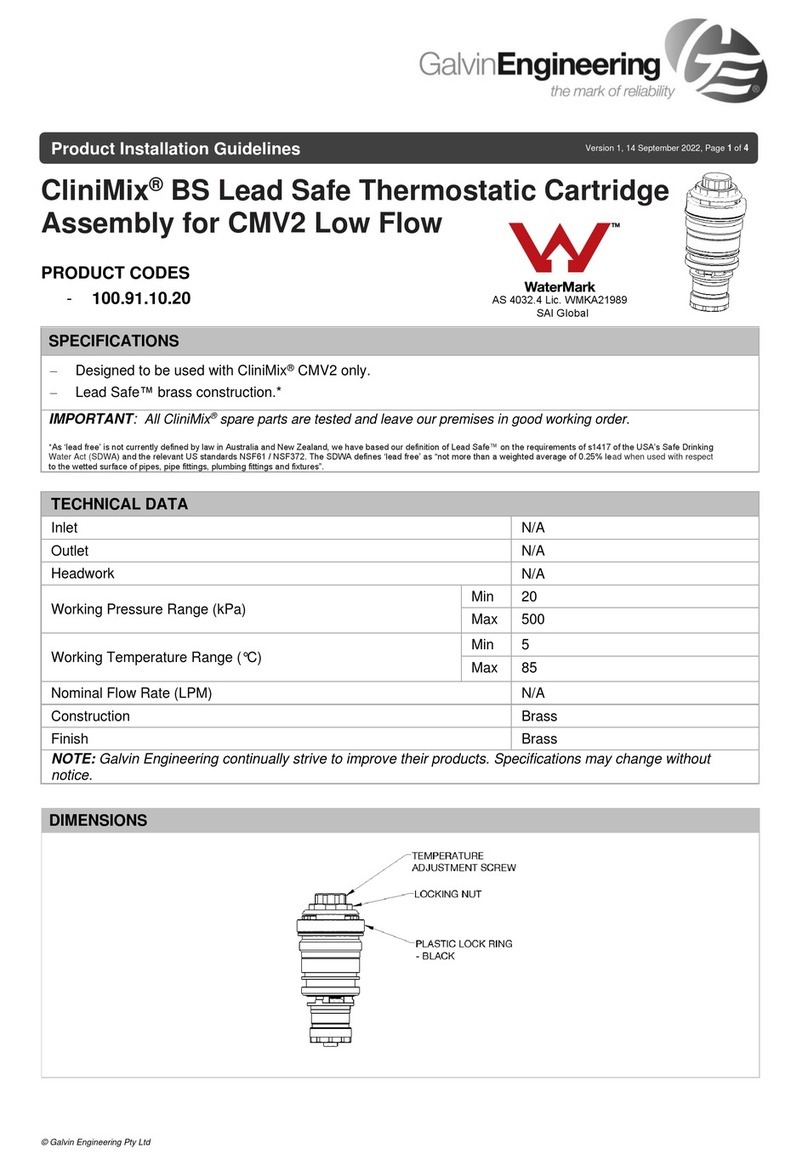
Galvin Engineering
Galvin Engineering CliniMix 100.91.10.20 Installation guidelines
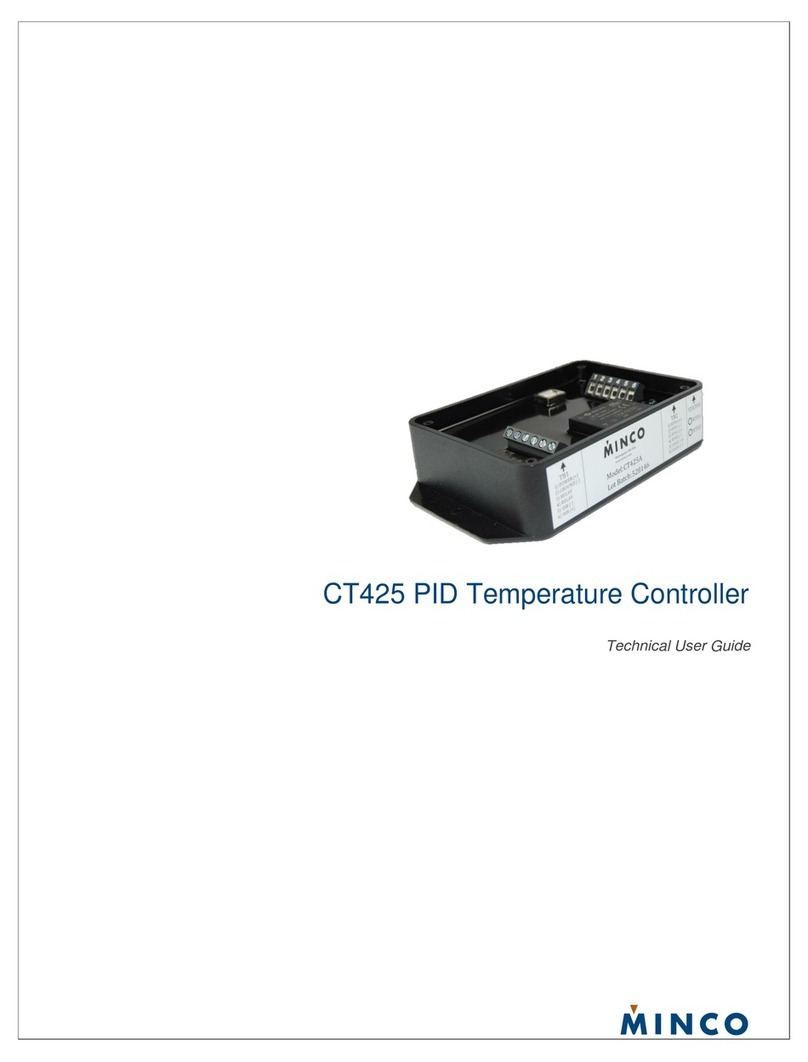
Minco
Minco CT425 Technical user guide
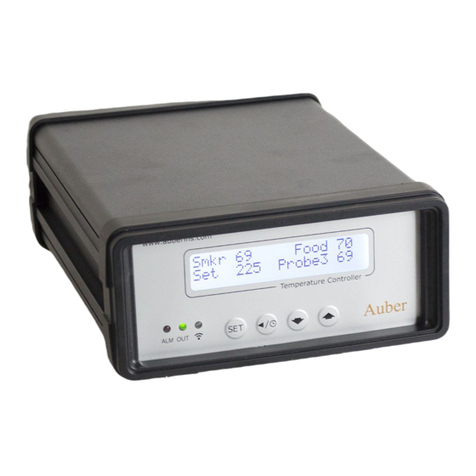
Auber Instruments
Auber Instruments WSD-1500H-W Operation & instruction manual

2VV
2VV ESSENSSE NEO COMFORT Installation and operation instractions
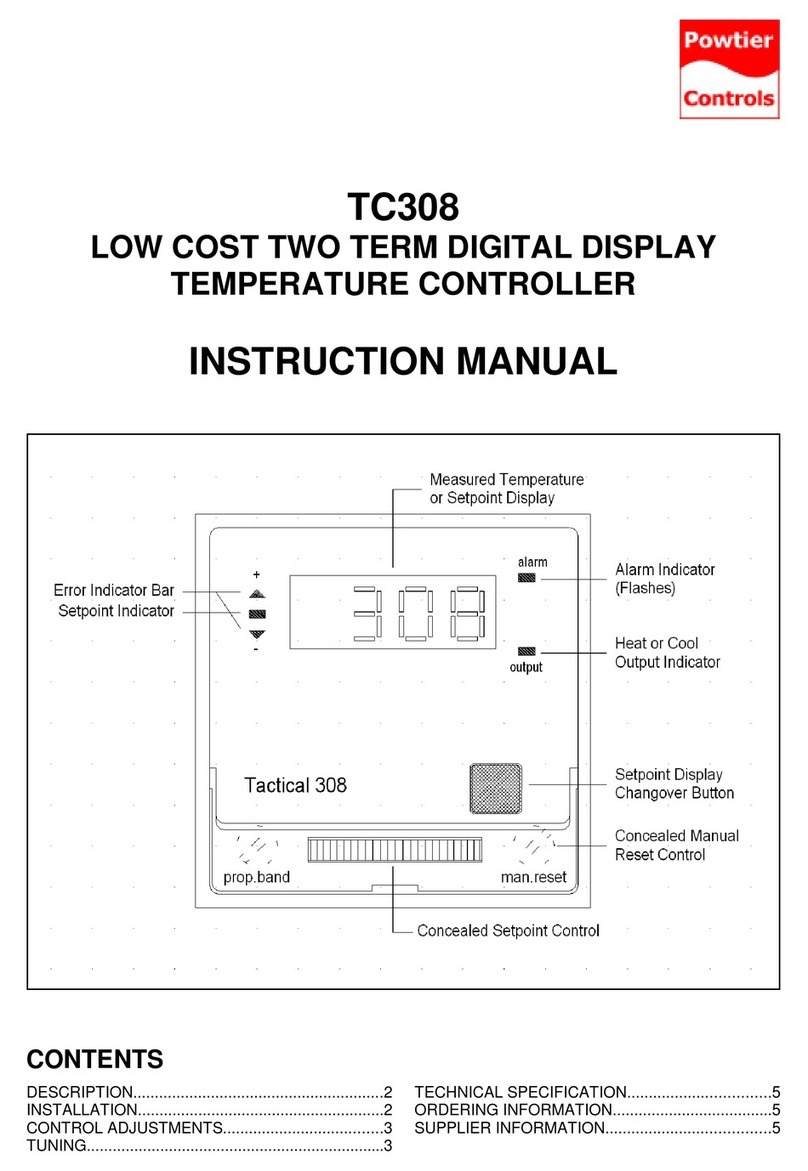
Powtier Controls
Powtier Controls TC308 instruction manual
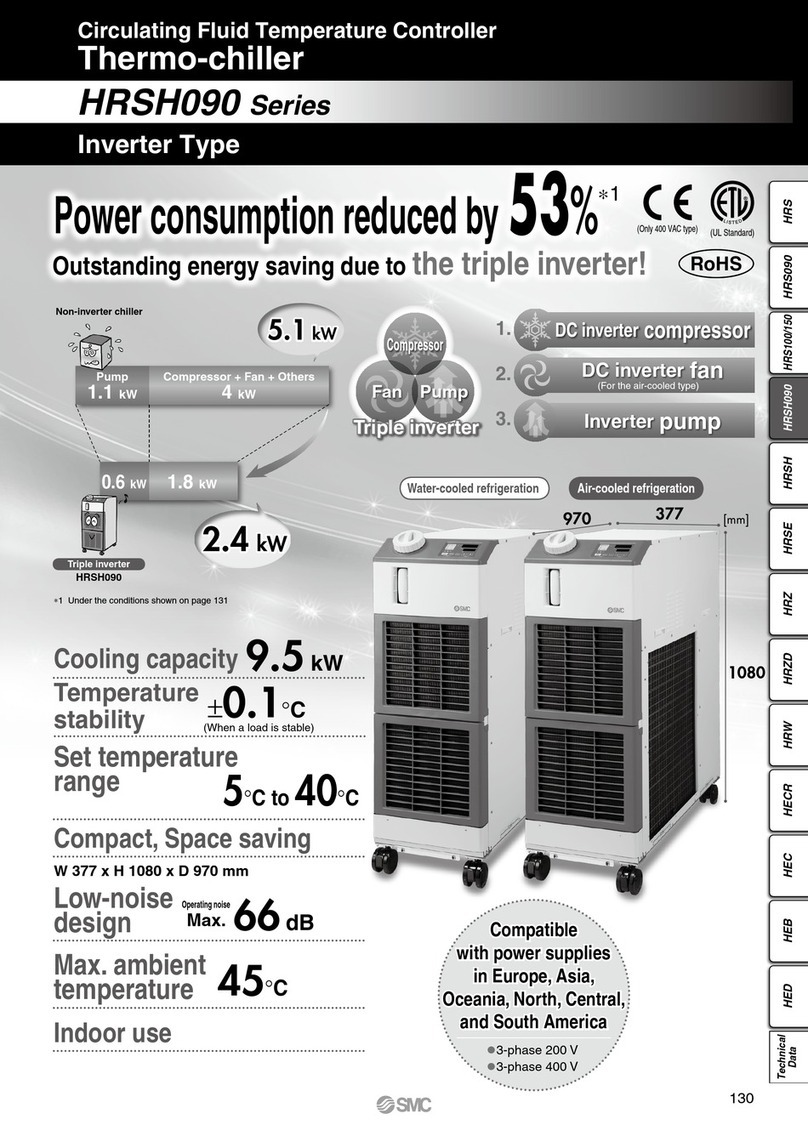
SMC Networks
SMC Networks HRSH090 Series Technical data
